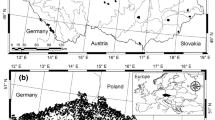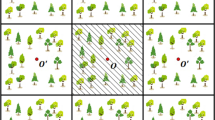Abstract
Using tree data from permanent sample plots and climate data from the ClimateWNA model, mixed-effects height to live crown (HTC) models were developed for three boreal tree species in Alberta, Canada: trembling aspen (Populus tremuloides Michx.), lodgepole pine (Pinus contorta var. latifolia Engelm.) and white spruce (Picea glauca (Moench) Voss). Three model forms, the Wykoff model, a logistic model and an exponential model, were evaluated for each species. Tree height was the most significant predictor of HTC and was used in all models. In addition, we investigated the effects of competition and climatic variables on HTC modelling. Height–diameter ratio and either total stand basal area or basal area of coniferous trees were used as competition measures in the models. Different climate variables were evaluated, and spring degree-days below 0 °C, mean annual precipitation and summer heat–moisture index were incorporated into the aspen, lodgepole pine and white spruce models, respectively. Site index was only significant in lodgepole pine models. Residual variances were modelled as functions of tree height to account for heteroscedasticity still present in the mixed-effects models after the inclusion of random parameters. Based on model fitting and validation results as well as biological realism, the mixed-effects Wykoff models were the best for aspen and white spruce, and the mixed-effects logistic model was the best for lodgepole pine.





Similar content being viewed by others
References
Alberta Sustainable Resource Development (2005) Permanent sample plot (PSP) field procedures manual. Forest Management Branch, Edmonton
Antos JA, Parish R, Nigh GD (2010) Effects of neighbours on crown length of Abies lasiocarpa and Picea engelmannii in two old-growth stands in British Columbia. Can J For Res 40:638–647
Barrow E, Yu G (2005) Climate scenarios for Alberta. Prairie Adaptation Research Collaborative, Regina
Bragg DC (2001) A local basal area adjustment for crown width prediction. North J Appl For 18:22–28
Burkhart HE, Farrar RL, Amateis RL, Daniels RF (1987) Simulation of individual tree growth and stand development in loblolly pine plantations on cutover, site-prepared areas. FWS-1-87, Virginia Polytechnic Institute and State University, Blacksburg
Chhin S, Hogg EH, Lieffers VJ, Huang S (2010) Growth–climate relationships vary with height along the stem in lodgepole pine. Tree Physiol 30:335–345
Cortini F, Comeau PG, Bokalo M (2012) Trembling aspen competition and climate effects on white spruce growth in boreal mixtures of Western Canada. For Ecol Manag 277:67–73
Crookston NL, Rehfeldt GE, Dixon GE, Weiskittel AR (2010) Addressing climate change in the forest vegetation simulator to assess impacts on landscape forest dynamics. For Ecol Manag 260:1198–1211
Davies O, Pommerening A (2008) The contribution of structural indices to the modelling of Sitka spruce (Picea sitchensis) and birch (Betula spp.) crowns. For Ecol Manag 256:68–77
Dudley MM, Negron J, Tisserat NA, Shepperd WD, Jacobi WR (2015) Influence of climate on the growth of quaking aspen (Populus tremuloides) in Colorado and southern Wyoming. Can J For Res 45:1546–1563
Dyer ME, Burkhart HE (1987) Compatible crown ratio and crown height models. Can J For Res 17:572–574
Fortin M, Bédard S, DeBlois J, Meunier S (2008) Accounting for error correlations in diameter increment modelling: a case study applied to northern hardwood stands in Quebec, Canada. Can J For Res 38:2274–2286
Fu L, Zhang H, Sharma RP, Pang L, Wang G (2017) A generalized nonlinear mixed-effects height to crown base model for Mongolian oak in northeast China. For Ecol Manag 384:34–43
Gill SJ, Biging GS, Murphy EC (2000) Modeling conifer tree crown radius and estimating canopy cover. For Ecol Manag 126:405–416
Hann DW, Walters DK, Scrivani JA (1987) Incorporating crown ratio into prediction equations for Douglas-fir stem volume. Can J For Res 17:17–22
Hasenauer H, Monserud RA (1996) A crown ratio model for Austrian forests. For Ecol Manag 84:49–60
Hatch CR (1980) Modeling tree crown size using inventory data. In: Johann K, Schmid-Haas P (eds.) Growth of single trees and development of stands. Proceedings of the IUFRO joint meeting of the working parties S 4.01-02, Estimation of increment, and S 4.02-03, inventories on successive occasions. Vienna, pp 93–99
Hegyi F (1974) A simulation model for managing jack-pine stands. In: Fries J (ed) Growth models for tree and stand simulation. Royal College of Forestry, Stockholm, pp 74–90
Hogg EH, Bernier PY (2005) Climate change impacts on drought-prone forests in western Canada. For Chron 81:675–682
Huang S, Meng SX, Yang Y (2009) Assessing the goodness-of-fit of forest models estimated by nonlinear mixed model methods. Can J For Res 39:2418–2436
Huang JG, Tardif J, Bergeron Y, Denneler B, Berninger F, Girardin MP (2010) Radial growth response of four dominant boreal tree species to climate along a latitudinal gradient in the eastern Canadian boreal forest. Glob Change Biol 16:711–731
Littell RC, Milliken GA, Stroup WW, Wolfinger RD, Schabenberger O (2006) SAS for mixed models, 2nd edn. SAS Institute Inc., Cary
Lorimer CG (1983) Tests of age-independent competition indices for individual trees in natural hardwood stands. For Ecol Manag 6:343–360
MacFarlane DW, Green EJ, Brunner A, Burkhart HE (2002) Predicting survival and growth rates for individual loblolly pine trees from light capture estimates. Can J For Res 32:1970–1983
McRoberts RE, Hahn JT, Hefty GJ, Van Cleve JR (1994) Variation in forest inventory field measurements. Can J For Res 24:1766–1770
Monserud RA, Sterba H (1996) A basal area increment model for individual trees growing in even- and uneven-aged forest stands in Austria. For Ecol Manag 80:57–80
Monserud RA, Yang Y, Huang S, Tchebakova N (2008) Potential change in lodgepole pine site index and distribution under climatic change in Alberta. Can J For Res 38:343–352
Paulo MJ, Stein A, Tomé MA (2002) Spatial statistical analysis of cork oak competition in two Portuguese silvopastoral systems. Can J For Res 32:1893–1903
Pinheiro JC, Bates DM (2004) Mixed-effects models in S and S-PLUS. Springer, New York
Popoola FS, Adesoye PO (2012) Crown ratio models for Tectona grandis (Linn. f) stands in Osho Forest Reserve, Oyo State, Nigeria. J For Sci 28:63–67
Power H, LeMay V, Berninger F, Sattler D, Kneeshaw D (2012) Differences in crown characteristics between black (Picea mariana) and white spruce (Picea glauca). Can J For Res 42:1733–1743
Rehfeldt GE, Crookston NL, Warwell MV, Evans JS (2006) Empirical analysis of plant-climate relationships for the western United States. Int J Plant Sci 167:1123–1150
Rijal B, Weiskittel AR, Kershaw JA Jr (2012) Development of height to crown base models for thirteen tree species of the North American Acadian Region. For Chron 88:60–73
Ritchie MW, Hann DW (1987) Equations for predicting height to crown base for fourteen tree species in southwest Oregon. Research Paper 50, Oregon State University, Corvallis
Sattler DF, LeMay V (2011) A system of nonlinear simultaneous equations for crown length and crown radius for the forest dynamics model SORTIE-ND. Can J For Res 41:1567–1576
Sheiner L, Beal SL (1980) Evaluation of methods for estimating population pharmacokinetic parameters. I. Michaelis–Mentem model: routine clinical pharmacokinetic data. J Pharmacokinet Biopharm 8:553–571
Short EA, Burkhart HE (1992) Predicting crown-height increment for thinned and unthinned loblolly-pine plantations. For Sci 38:594–610
Snowdon P, Jovanovic T, Booth TH (1999) Incorporation of indices of annual climatic variation into growth models for Pinus radiata. For Ecol Manag 117:187–197
Soares P, Tomé M (2001) A tree crown ratio prediction equation for eucalypt plantations. Ann For Sci 58:193–202
Temesgen H, LeMay V, Mitchell SJ (2005) Tree crown ratio models for multi-species and multi-layered stands of southeastern British Columbia. For Chron 81:133–141
Thorpe HC, Astrup R, Trowbridge A, Coates KD (2010) Competition and tree crowns: a neighborhood analysis of three boreal tree species. For Ecol Manag 259:1586–1596
Vonesh EF, Chinchilli VM (1997) Linear and nonlinear models for the analysis of repeated measurements. Marcel Dekker, New York
Walters DK, Hann DW (1986) Taper equations for six conifer species in southwest Oregon. Research Bulletin 56, Oregon State University, Corvallis
Wang M, Bhatti J, Wang Y, Varem-Sanders T (2011) Examining the gain in model prediction accuracy using serial autocorrelation for dominant height prediction. For Sci 57:241–251
Wang T, Hamann A, Spittlehouse DL, Murdock TQ (2012) ClimateWNA—high-resolution spatial climate data for western North America. J Appl Meteorol Climatol 51:16–29
Way DA, Oren R (2010) Differential responses to changes in growth temperature between trees from different functional groups and biomes: a review and synthesis of data. Tree Physiol 30:669–688
Weiskittel AR, Hann DW, Kershaw JA Jr, Vanclay JK (2011) Forest growth and yield modeling. Wiley, Chichester
Wykoff WR, Crookston NL, Stage AR (1982) User’s guide to the stand prognosis model. USDA Forest Service Intermountain Forest and Range Experiment Station, Ogden
Yang Y, Huang S (2011) Estimating a multilevel dominant height-age model from nested data with generalized errors. For Sci 57:102–116
Yang Y, Huang S (2017) Allometric modelling of crown width for white spruce by fixed- and mixed-effects models. For Chron 93:138–147
Acknowledgements
This research was supported by the Alberta Government. The constructive comments and suggestions from the anonymous reviewers are appreciated.
Author information
Authors and Affiliations
Corresponding author
Additional information
Communicated by Arne Nothdurft.
Rights and permissions
About this article
Cite this article
Yang, Y., Huang, S. Effects of competition and climate variables on modelling height to live crown for three boreal tree species in Alberta, Canada. Eur J Forest Res 137, 153–167 (2018). https://doi.org/10.1007/s10342-017-1095-7
Received:
Revised:
Accepted:
Published:
Issue Date:
DOI: https://doi.org/10.1007/s10342-017-1095-7




